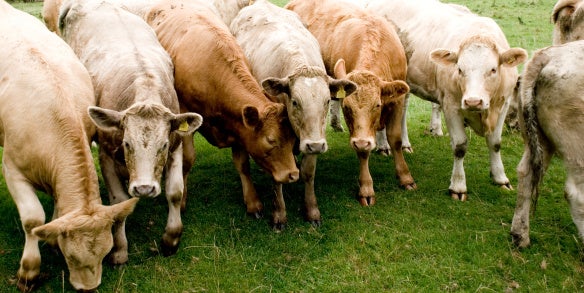What is foot and mouth disease and can humans get it?
Foot and mouth is a potentially fatal and highly infectious disease that affects cloven-hoofed animals

Health officials are investigating a suspected outbreak of foot and mouth disease, prompting the enforcement of a 10km control zone around a west Norfolk pig farm.
The restriction prevents the movement of any animal at risk of being infected in or out of the site near Feltwell, Kings Lynn.
Foot and mouth disease, which has nothing to do with hand, foot and mouth disease common among children, affects cloven-hoofed animals, including cattle, sheep and pigs.
“Following suspicion of vesicular disease in pigs, and as a precaution to prevent the spread of disease, a 10km temporary control zone has been declared around a premises near Feltwell, Kings Lynn and west Norfolk, Norfolk,” a statement issued by the Department for Environment, Food and Rural Affairs (Defra) said.
“The premises remains under restrictions pending further tests,” it added.
National Farmers Union (NFU) East Anglia regional director and former National Pig Association chief executive Zoe Davies said that the control zone is precautionary at this stage.
“We are waiting, keeping everything crossed and praying it isn’t what they suspect it is,” Dr Davies said.
While a Defra spokesperson added: “We are currently investigating a suspected case of Foot and Mouth Disease in England.
“Movement restrictions and a 10km temporary control zone have been put in place on the farm in Norfolk as a precaution. Preliminary testing does not indicate the presence of disease, but further work is now underway to fully rule it out.”
Here are the key questions and answers about the disease:
What is foot and mouth disease?
Foot and mouth disease is a potentially fatal and highly infectious disease that affects cloven-hoofed animals.
Sometimes referred to as hoof and mouth disease, it reveals itself via a number of symptoms, including a high fever, blisters in the mouth and lameness.
Indicators of foot and mouth disease differ among cattle, sheep and pigs.
Alongside blisters, cattle will likely show signs of fever, shivering, lameness, slobbering and lip smacking. The disease also causes cows to produce less milk, according to Defra.
It is rare that sheep will develop mouth blisters as a result of the disease, and any that emerge in either location tend to be small and hard to spot.
Among sheep, lameness is the main sign of the disease, which can develop suddenly and spread rapidly among the flock. High numbers of stillbirths and lambs dying soon after birth are also common symptoms.
Pigs are similarly unlikely to contract mouth blisters, which develop on the upper edge of the hoof where the skin and horn meet, the snout and the tongue.
Goats, deer and other cloven-hoofed animals can also be infected and introduce the disease to livestock.
How does foot and mouth disease spread?
The virus is highly infectious and is most commonly spread through direct contact with an infected animal.
But Defra also warns that the disease can be passed onto animals indirectly through equipment, vehicles, people, clothes, mud, bedding and any other item that has been in contact with infected animals.
The virus is found in the infected animals’ blister fluid, their saliva, urine, dung, milk and exhaled air before signs of the disease become apparent.
When was the last major UK outbreak?
The 2001 outbreak of foot and mouth disease lasted almost a year and cost the economy more than £8 billion. More than 2,000 cases were recorded in farms across most of the British countryside.
At least 7 million animals were slaughtered and it took the British meat industry several years to recover. Tourism was also badly hit as access to the countryside was restricted.
The 2007 outbreak in Surrey led to the slaughter of 600 cattle and a three-week ban on livestock exports.
Can foot and mouth disease infect humans?
Although foot and mouth disease can be transmitted from animals to humans, it is extremely rare.
The last human case reported in the UK occured in 1966. The disease in humans, in the very rare cases that have arisen, is mild, short-lived and requires no medical treatment.
Foot and mouth disease is often confused with hand, foot and mouth disease, a common childhood illness that can also affect adults.
Join our commenting forum
Join thought-provoking conversations, follow other Independent readers and see their replies
Comments
Bookmark popover
Removed from bookmarks